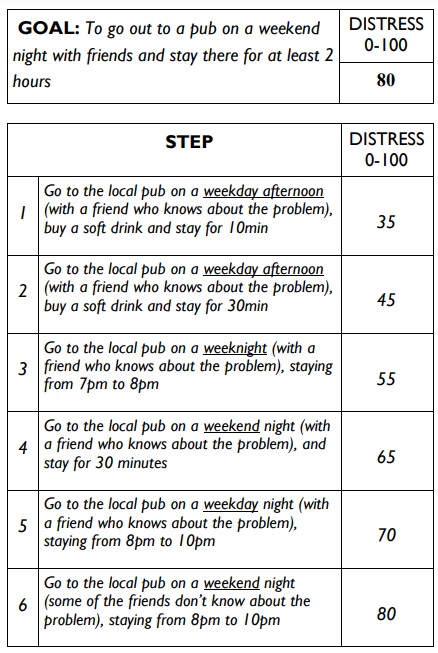Social anxiety hierarchies and graded exposure
It is common for people with social anxiety to engage in safety behaviours and avoidance to minimise the anxiety they feel. Behaviours such as distracting yourself with a phone or avoiding a social event altogether can give immediate relief. However, continuous of avoidance and safety behaviours may mean that social anxiety does not improve and can become worse. By not facing fearful situations negative thoughts about them aren’t challenged. Too much avoidance can decrease quality of life as a result.
People with social anxiety might have situations where they feel only mild anxiety, where their comfort zone can be pushed quite easily to conquer them. However, with more intense anxiety-inducing situations, gradually building up to face them can be useful. Gradual exposure and social anxiety hierarchies can help to break down anxious situations into a step-by-step process. Through this method, confidence and skills can be built in a structured and steady way rather than social anxiety sufferers jumping into the deep end.
Social anxiety hierarchies
Hierarchies are a pivotal part of CBT and behaviour-based therapy. The first step is to list create a list of all situations that provoke social anxiety. The next is give each situation a score for how much anxiety it produces. For example, the groupings below are based on a 0-100 score.
Next the situations are arranged on a hierarchy with the easiest tasks first and the hardest task last.
Then each situation should be broken down further into a series of manageable steps that can be faced. Each step should be listed as specifically as possible, for example, the setting, the number of people around and the time of day.
Some people might feel very anxious about attending an evening social event at a bar with people they are unfamiliar with. In order to build up to doing this, the situation can be broken down into the following steps:

The number of steps in the hierarchy can differ for every individual. The number of steps can also differ for each different situation. Each step of the ladder can be attempted multiple times until the individual becomes confident and is ready to proceed to the next step.
The intention of social anxiety hierarchies
The intention of social hierarchies is to try and gradually manage the fear felt in anxious situations, starting from easier tasks and building up to harder tasks. Skills for managing anxiety can be built over time and the hope is to end up with a more confident mindset towards the fearful scenario.
Sufferers of social anxiety can use techniques such as breathing exercises, mindfulness and focusing outward rather than inwards to help with the physical symptoms of anxiety during every task. The steps can also help challenge negative thoughts that have built up about the situation.
By facing anxious situations gradually, we aren’t overwhelming ourselves by jumping in at the deep end. We are creating momentum and moving on to tougher steps, and applying skills step-by-step to eventually confidently face a situation that was previously very anxiety-inducing.
It’s suggested that individuals don’t rush, and ensure they become comfortable and relaxed at each stage before progressing to the next. If a step becomes too overwhelming, they can return to a lower step to build on their skills of managing their anxiety. Steps can be repeated and practised multiple times. The number of repetitions varies from person to person.
Benefits
- With gradual and repeated exposure, anxiety and fear can decrease over time
- Those who have social anxiety can learn that some situations don’t pose a threat
- People with social anxiety can explore and understand their fear and replace their fear response with more helpful thoughts and beliefs in a gradual way
- Eventually they can start to believe in themselves and think that it is possible to manage their social anxiety
Things to consider
- Doing steps in the social anxiety hierarchy may be challenging and uncomfortable
- Anxiety should be expected but it might be helpful to remind yourself that anxiety is a biological response to keep us safe
- It would be helpful to stay involved and aware while undertaking in exposure steps. Try to avoid using safety behaviours or being unaware, for example by being inebriated
- Exposure therapy and hierarchies can be challenging as social situations are dynamic, people can join or leave a planned situation causing all your plans to change.
- Celebrate each step you work on and treat yourself with patience and kindness
Coping with setbacks
Even as you begin to make progress it is likely that setbacks – and recurrences of intense social anxiety – may happen at times. Even a well planned “behavioural experiment” may be scuppered by unexpected circumstance. Coping with setbacks, allowing time to pass and trying again are all parts of the journey to getting better.
Remember
Overcoming social anxiety is not quite as simple as just “Face your fears and they’ll go away”. We, as people with social anxiety, have constantly faced our fears – we’ve had to – and often the fear remains. Getting better works best as part of a comprehensive cognitive-behavioural approach. Be gentle with yourself and see our pages on “Roadmap to Making Progress“.
Further reading
https://www.anxietycanada.com/Examples_of_Fear_Ladders.pdf
https://www.cci.health.wa.gov.au/Situational-Exposure.pdf
www.betterhelp.com/advice/anxiety/anxiety-hierarchy-treatment-for-anxiety-disorders/
https://www.healthline.com/health/systematic-desensitization#examples

